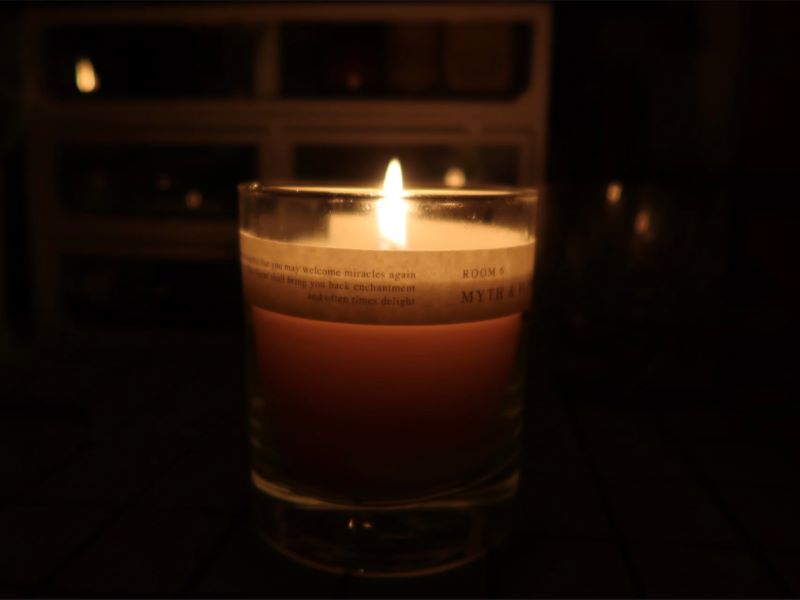Without light you wouldn’t be able to see what was going on around you. Even the simplest things, like brushing your teeth, require light in order to make sure they actually get clean.
The use of natural light, like sunshine, can help you conserve energy usage. But artificial light, as in lamps and candles, gives you more control over the amount of light that’s produced and for how long.
Let’s explore the major differences between natural and artificial light sources and the usefulness of candlelight even though it’s artificial.

Do Candles Produce Natural Light?
There is a lot of confusion surrounding this question because although candles are man-made, we believe that fire is natural. And in some cases, it is.
When lightning strikes a tree, that tree can begin to combust. This is a natural fire because it was generated by itself.
When fire is generated by human effort, it can’t ignite or maintain a flame on its own.
In order for combustion to occur and flames to form, three things must be present: fuel, oxygen, and energy (usually in the form of heat). Once energy starts the reaction, it continues so long as fuel and oxygen are present.
Source
Heat and light produced by man made fire is the result of a chemical reaction.
If there isn’t fuel and oxygen to maintain the fire, then it eventually subsides. In this way, it’s not producing its own light. This isn’t true of the Sun, for instance. We can’t simply extinguish its process of nuclear fusion. Even when the Sun sets, it still shines and we know this because it gives the Moon its light.
And when we use matches or lighters to start a fire, many different factors and conditions have to be true in order to produce that fire.
You’ll notice that matches aren’t simply made of wood. They have a match head that’s usually red, green, black, or another color. These match heads have active ingredients. Usually, they’re made of a mixture of potassium chlorate, sulfur, fillers, and glass powder.
The scratchy surface on the side of a box of matches is usually made of red phosphorus, a bunder, and more glass powder. Once struck, a chain of chemical reactions causes the match to produce fire.
Lighters also produce fires from chemical reactions.
Takeaway: Because we have to light candles with matches or lighters, candles do not produce light on their own. They are considered an artificial light source.
What’s the Difference Between Natural & Artificial Light?
Broadly speaking, anything that makes light is a light source. This can include the Sun, candles, light bulbs, smartphone backlighting, the stars, and so forth.
Some of these sources are natural, others aren’t. And some objects, like the Moon, appear to be a light source when it’s truly a reflection of the sun’s light and doesn’t produce its own.
So we have natural light sources, artificial light sources, and non-luminous objects, how can we tell the difference between them?
Natural Light Sources
Light that’s produced without any human involvement is considered a natural light source. Here are a couple examples of natural light sources that we actually use in our day-to-day functioning.
The Sun
The Earth’s primary source of light and heat is the Sun. We need its energy to survive and plants can’t grow without it. Life as we know it wouldn’t exist without the Sun.
Exposure to natural light provides so many benefits. Here are a few:
- Our bodies absorb Vitamin D, which helps regulate mood and bodily systems, as well as build and maintain a healthy skeletal system.
- Improves sleeping patterns
- Increases focus
- Helps us be more productive
Design plays a huge role in the amount of sunlight that you’re exposed to within your home.
Windows and skylights are one way that architects ensure that you encounter natural sunlight regularly. But they also consider how sunlight will reflect off of interior objects, the amount of heat the Sun will produce, and more specific factors.
All of this determines just how many windows will be installed and how they’ll be spaced. These considerations also impact energy and cost efficiency.
Stars
A star is a self-luminous body of gas suspended in the sky that can appear on its own, as a pair, or part of systems or clusters.
The amount of light produced varies by star and the number of stars present at once in one area. They radiate light from their own internal energy sources, but we don’t see much of it due to their distance from the earth.
Bioluminescent Organisms
I don’t know if you ever caught fireflies as a child, but we did. We’d collect them in a jar, screw on a lid with small holes for oxygen to circulate, and then use the jar as a natural flashlight.
More organisms that light on their own include fungus, squid, bacteria, and fish. To us, they might be beautiful and awe-inspiring, but these organisms glow with a purpose.
Here are some reasons:
- Deter predators
- Attract mates
- Attract their enemies’ predators
- Lure prey
So life, death, and reproduction are their motivating factors.
Other natural phenomena that can produce natural light are lightning, which is electricity produced by storms, and wildfires or bushfires that are an act of nature, not man.
Artificial Light Sources
Light that’s created by humans is considered artificial light. In addition to candlelight, artificial light sources include:
- Flashlights
- Light bulbs
- Lasers
- Lanterns
- Street Lights/Lamps
- Televisions
- Fire produced by matches or lighters
- Fireworks
- Mobile phone backlights
These light sources are helpful when natural light sources are inaccessible. In the evenings when there’s no longer any sunlight, the light that’s reflected by the moon doesn’t really help us move around. We need streetlights, indoor lighting, and so forth in order to continue living life once the sun sets.
Non-Luminous Objects
The Moon is the best example of a non-luminous object that appears to produce light, but it isn’t the only one.
You can also find reflected light:
- On the surface of smooth water
- Bounce off of shiny objects like metal roofs
- Bounce off of mirrors
These objects can make a space or environment feel brighter, but it’s only because they’re reflecting what’s already there.
Can Artificial Candlelight be Beneficial?
If you’re a candle lover you can still benefit from burning candles, even though the light isn’t natural. Artificial light can be as helpful to us as natural light sources. Burning candles can help improve your overall wellness:
- Staring at the candle flame can slow your heart rate and help you relax. This can be beneficial during meditation, or even if you want to reduce anxiety symptoms.
- Lighting aromatherapy candles can produce many benefits, depending on the kind of essential oil that’s been used. For instance, peppermint or citrus candles can invigorate you and help lift your mood.
- Lighting multiple candles can create a low glowing light in your home, which can be relaxing and inviting. This is also a great option when hosting an elegant event at home.
- Regular scented candles can also set a tone in your home. For instance, many people enjoy burning pine-scented candles during the holiday season to help them celebrate and make their homes feel more inviting to visitors.
You can see that although candles are a source of artificial light, they are still a valuable light source.
Read more:
